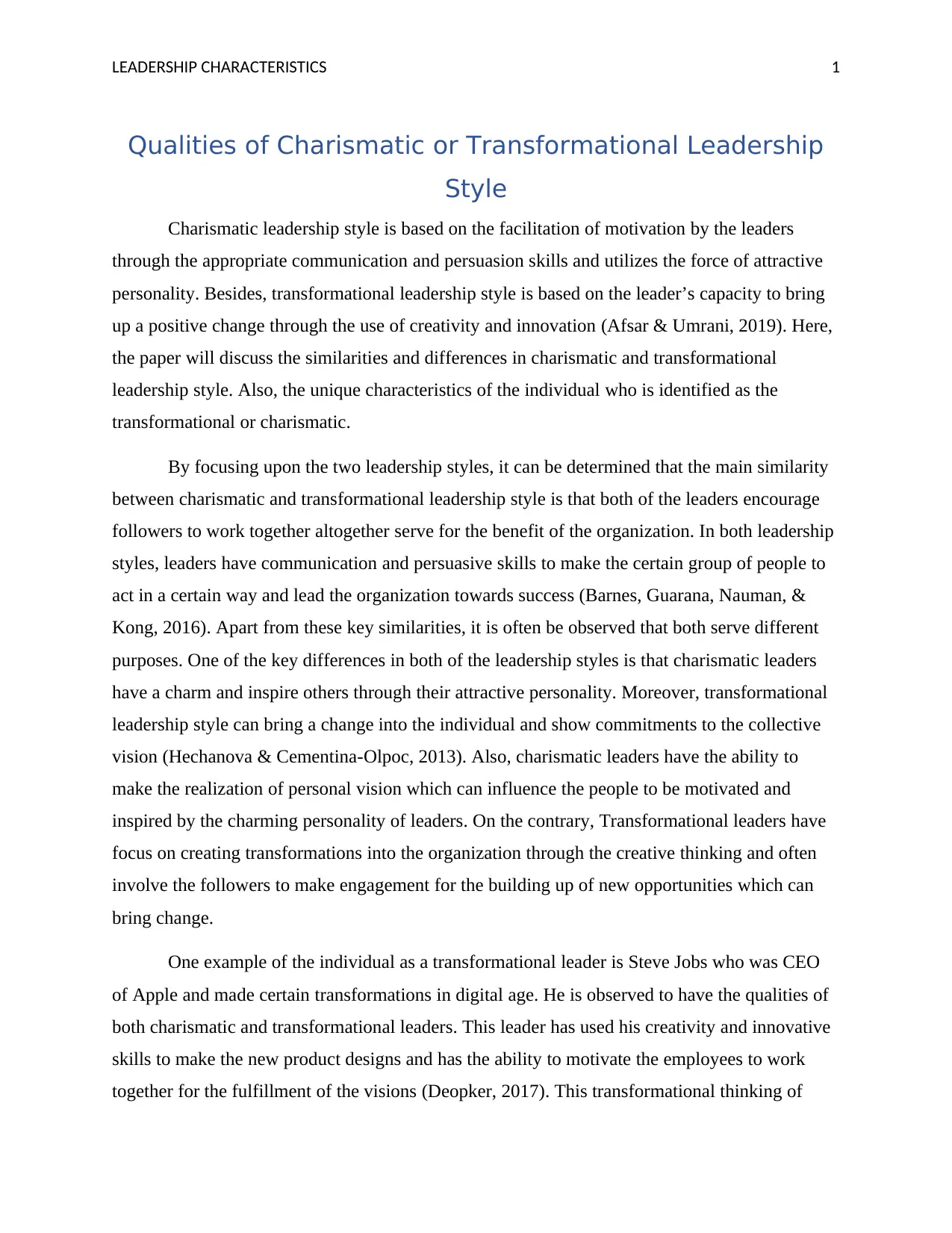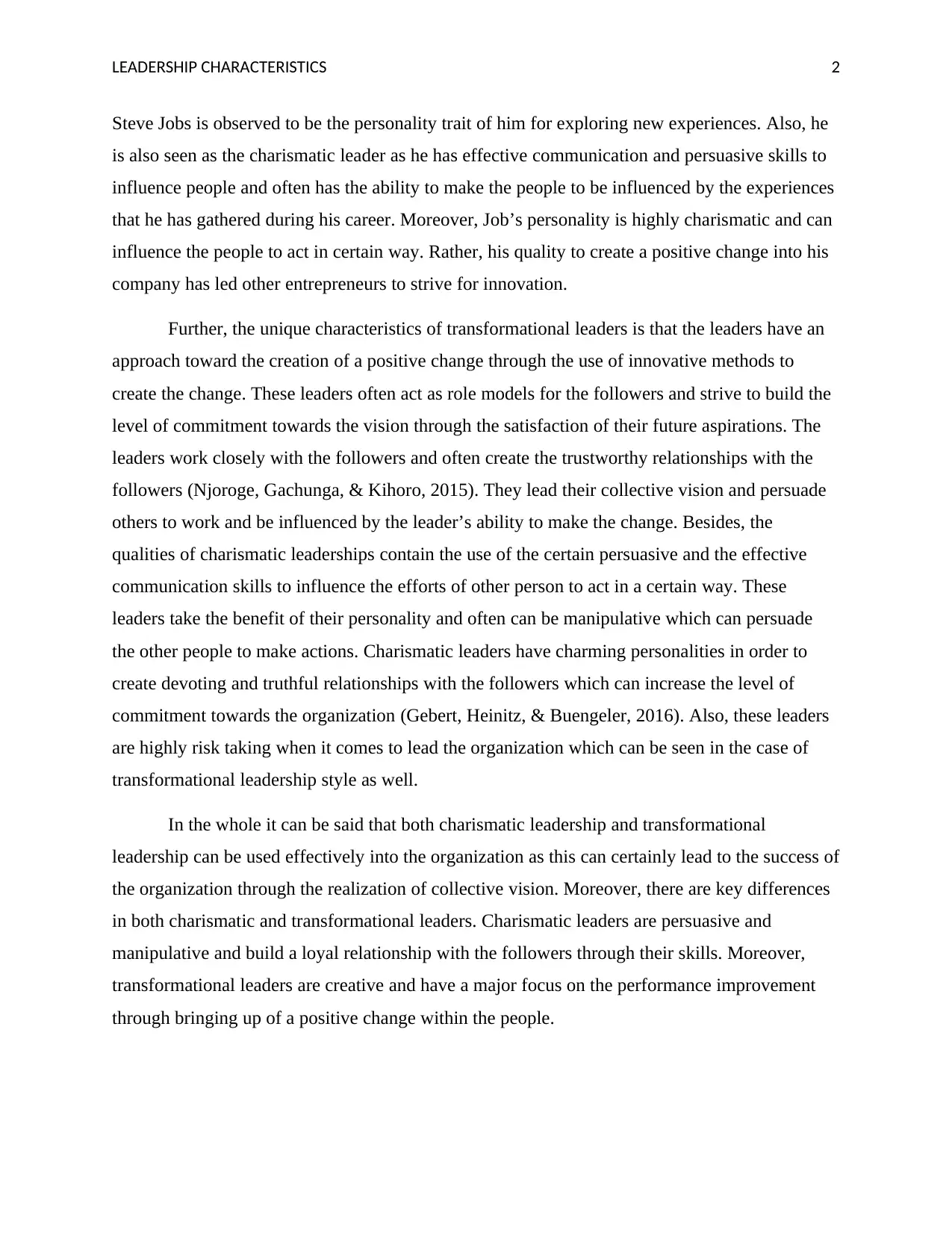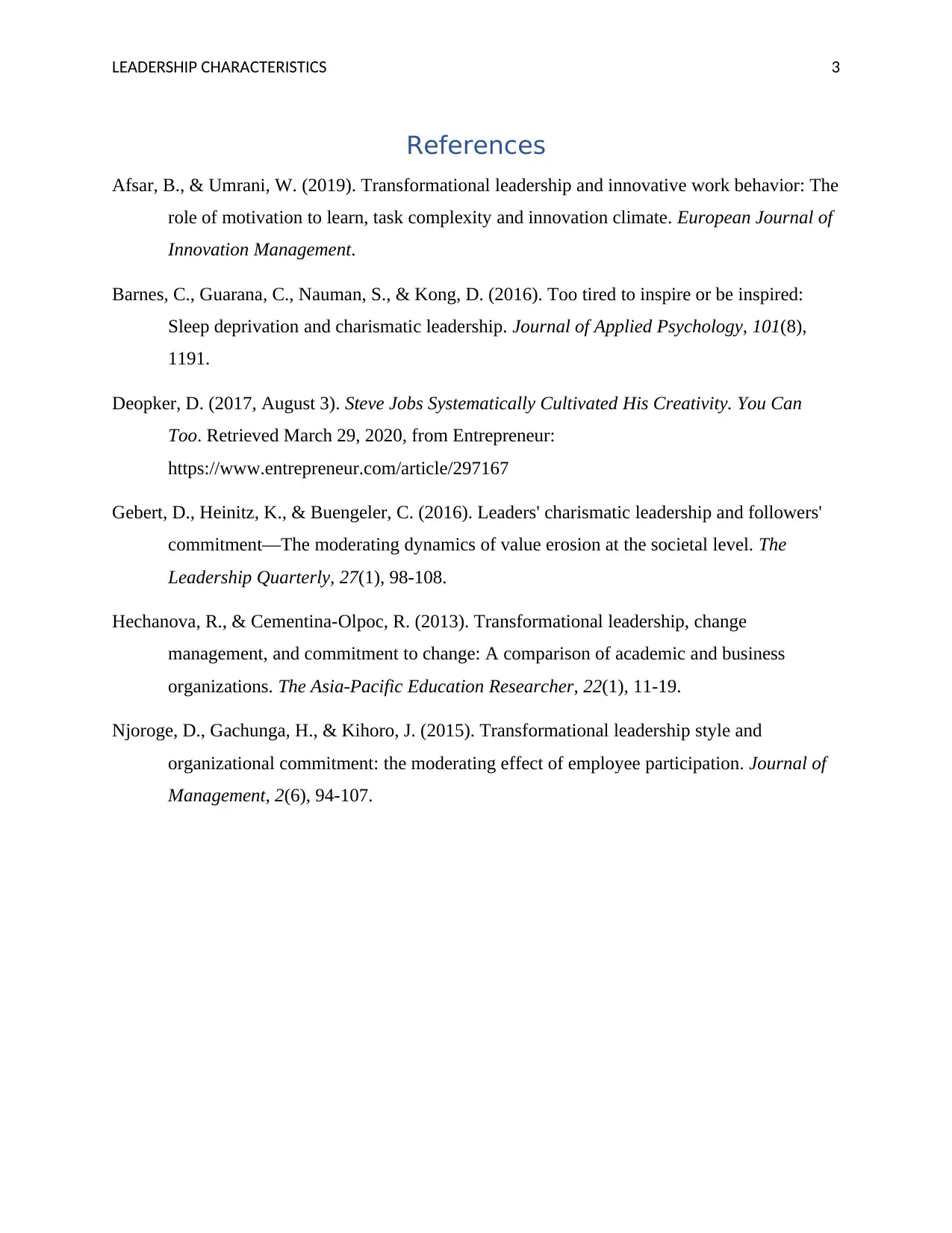Leadership Analysis: Comparing Charismatic and Transformational Styles
VerifiedAdded on 2022/08/29
|4
|1104
|18
Essay
AI Summary
This essay delves into the contrasting yet interconnected realms of charismatic and transformational leadership styles. It begins by highlighting the shared characteristic of inspiring followers towards organizational goals through effective communication and persuasion. The essay then differentiates the styles, emphasizing how charismatic leaders leverage their charm and personality to motivate, while transformational leaders drive change through innovation and commitment to a collective vision. Using Steve Jobs as an example, the essay illustrates how a leader can embody traits of both styles, utilizing creativity and persuasive skills to influence and create positive change. Furthermore, the essay explores the unique characteristics of each style, detailing the transformational leader's focus on positive change through innovation and the charismatic leader's reliance on persuasive communication. In conclusion, the essay asserts the effectiveness of both styles in achieving organizational success, while acknowledging their distinct approaches.

RUNNING HEAD: LEADERSHIP CHARACTERISTICS 0
Leadership Characteristics
Student’s Details-
3-29-2020
Leadership Characteristics
Student’s Details-
3-29-2020
Paraphrase This Document
Need a fresh take? Get an instant paraphrase of this document with our AI Paraphraser

LEADERSHIP CHARACTERISTICS 1
Qualities of Charismatic or Transformational Leadership
Style
Charismatic leadership style is based on the facilitation of motivation by the leaders
through the appropriate communication and persuasion skills and utilizes the force of attractive
personality. Besides, transformational leadership style is based on the leader’s capacity to bring
up a positive change through the use of creativity and innovation (Afsar & Umrani, 2019). Here,
the paper will discuss the similarities and differences in charismatic and transformational
leadership style. Also, the unique characteristics of the individual who is identified as the
transformational or charismatic.
By focusing upon the two leadership styles, it can be determined that the main similarity
between charismatic and transformational leadership style is that both of the leaders encourage
followers to work together altogether serve for the benefit of the organization. In both leadership
styles, leaders have communication and persuasive skills to make the certain group of people to
act in a certain way and lead the organization towards success (Barnes, Guarana, Nauman, &
Kong, 2016). Apart from these key similarities, it is often be observed that both serve different
purposes. One of the key differences in both of the leadership styles is that charismatic leaders
have a charm and inspire others through their attractive personality. Moreover, transformational
leadership style can bring a change into the individual and show commitments to the collective
vision (Hechanova & Cementina-Olpoc, 2013). Also, charismatic leaders have the ability to
make the realization of personal vision which can influence the people to be motivated and
inspired by the charming personality of leaders. On the contrary, Transformational leaders have
focus on creating transformations into the organization through the creative thinking and often
involve the followers to make engagement for the building up of new opportunities which can
bring change.
One example of the individual as a transformational leader is Steve Jobs who was CEO
of Apple and made certain transformations in digital age. He is observed to have the qualities of
both charismatic and transformational leaders. This leader has used his creativity and innovative
skills to make the new product designs and has the ability to motivate the employees to work
together for the fulfillment of the visions (Deopker, 2017). This transformational thinking of
Qualities of Charismatic or Transformational Leadership
Style
Charismatic leadership style is based on the facilitation of motivation by the leaders
through the appropriate communication and persuasion skills and utilizes the force of attractive
personality. Besides, transformational leadership style is based on the leader’s capacity to bring
up a positive change through the use of creativity and innovation (Afsar & Umrani, 2019). Here,
the paper will discuss the similarities and differences in charismatic and transformational
leadership style. Also, the unique characteristics of the individual who is identified as the
transformational or charismatic.
By focusing upon the two leadership styles, it can be determined that the main similarity
between charismatic and transformational leadership style is that both of the leaders encourage
followers to work together altogether serve for the benefit of the organization. In both leadership
styles, leaders have communication and persuasive skills to make the certain group of people to
act in a certain way and lead the organization towards success (Barnes, Guarana, Nauman, &
Kong, 2016). Apart from these key similarities, it is often be observed that both serve different
purposes. One of the key differences in both of the leadership styles is that charismatic leaders
have a charm and inspire others through their attractive personality. Moreover, transformational
leadership style can bring a change into the individual and show commitments to the collective
vision (Hechanova & Cementina-Olpoc, 2013). Also, charismatic leaders have the ability to
make the realization of personal vision which can influence the people to be motivated and
inspired by the charming personality of leaders. On the contrary, Transformational leaders have
focus on creating transformations into the organization through the creative thinking and often
involve the followers to make engagement for the building up of new opportunities which can
bring change.
One example of the individual as a transformational leader is Steve Jobs who was CEO
of Apple and made certain transformations in digital age. He is observed to have the qualities of
both charismatic and transformational leaders. This leader has used his creativity and innovative
skills to make the new product designs and has the ability to motivate the employees to work
together for the fulfillment of the visions (Deopker, 2017). This transformational thinking of

LEADERSHIP CHARACTERISTICS 2
Steve Jobs is observed to be the personality trait of him for exploring new experiences. Also, he
is also seen as the charismatic leader as he has effective communication and persuasive skills to
influence people and often has the ability to make the people to be influenced by the experiences
that he has gathered during his career. Moreover, Job’s personality is highly charismatic and can
influence the people to act in certain way. Rather, his quality to create a positive change into his
company has led other entrepreneurs to strive for innovation.
Further, the unique characteristics of transformational leaders is that the leaders have an
approach toward the creation of a positive change through the use of innovative methods to
create the change. These leaders often act as role models for the followers and strive to build the
level of commitment towards the vision through the satisfaction of their future aspirations. The
leaders work closely with the followers and often create the trustworthy relationships with the
followers (Njoroge, Gachunga, & Kihoro, 2015). They lead their collective vision and persuade
others to work and be influenced by the leader’s ability to make the change. Besides, the
qualities of charismatic leaderships contain the use of the certain persuasive and the effective
communication skills to influence the efforts of other person to act in a certain way. These
leaders take the benefit of their personality and often can be manipulative which can persuade
the other people to make actions. Charismatic leaders have charming personalities in order to
create devoting and truthful relationships with the followers which can increase the level of
commitment towards the organization (Gebert, Heinitz, & Buengeler, 2016). Also, these leaders
are highly risk taking when it comes to lead the organization which can be seen in the case of
transformational leadership style as well.
In the whole it can be said that both charismatic leadership and transformational
leadership can be used effectively into the organization as this can certainly lead to the success of
the organization through the realization of collective vision. Moreover, there are key differences
in both charismatic and transformational leaders. Charismatic leaders are persuasive and
manipulative and build a loyal relationship with the followers through their skills. Moreover,
transformational leaders are creative and have a major focus on the performance improvement
through bringing up of a positive change within the people.
Steve Jobs is observed to be the personality trait of him for exploring new experiences. Also, he
is also seen as the charismatic leader as he has effective communication and persuasive skills to
influence people and often has the ability to make the people to be influenced by the experiences
that he has gathered during his career. Moreover, Job’s personality is highly charismatic and can
influence the people to act in certain way. Rather, his quality to create a positive change into his
company has led other entrepreneurs to strive for innovation.
Further, the unique characteristics of transformational leaders is that the leaders have an
approach toward the creation of a positive change through the use of innovative methods to
create the change. These leaders often act as role models for the followers and strive to build the
level of commitment towards the vision through the satisfaction of their future aspirations. The
leaders work closely with the followers and often create the trustworthy relationships with the
followers (Njoroge, Gachunga, & Kihoro, 2015). They lead their collective vision and persuade
others to work and be influenced by the leader’s ability to make the change. Besides, the
qualities of charismatic leaderships contain the use of the certain persuasive and the effective
communication skills to influence the efforts of other person to act in a certain way. These
leaders take the benefit of their personality and often can be manipulative which can persuade
the other people to make actions. Charismatic leaders have charming personalities in order to
create devoting and truthful relationships with the followers which can increase the level of
commitment towards the organization (Gebert, Heinitz, & Buengeler, 2016). Also, these leaders
are highly risk taking when it comes to lead the organization which can be seen in the case of
transformational leadership style as well.
In the whole it can be said that both charismatic leadership and transformational
leadership can be used effectively into the organization as this can certainly lead to the success of
the organization through the realization of collective vision. Moreover, there are key differences
in both charismatic and transformational leaders. Charismatic leaders are persuasive and
manipulative and build a loyal relationship with the followers through their skills. Moreover,
transformational leaders are creative and have a major focus on the performance improvement
through bringing up of a positive change within the people.
⊘ This is a preview!⊘
Do you want full access?
Subscribe today to unlock all pages.

Trusted by 1+ million students worldwide

LEADERSHIP CHARACTERISTICS 3
References
Afsar, B., & Umrani, W. (2019). Transformational leadership and innovative work behavior: The
role of motivation to learn, task complexity and innovation climate. European Journal of
Innovation Management.
Barnes, C., Guarana, C., Nauman, S., & Kong, D. (2016). Too tired to inspire or be inspired:
Sleep deprivation and charismatic leadership. Journal of Applied Psychology, 101(8),
1191.
Deopker, D. (2017, August 3). Steve Jobs Systematically Cultivated His Creativity. You Can
Too. Retrieved March 29, 2020, from Entrepreneur:
https://www.entrepreneur.com/article/297167
Gebert, D., Heinitz, K., & Buengeler, C. (2016). Leaders' charismatic leadership and followers'
commitment—The moderating dynamics of value erosion at the societal level. The
Leadership Quarterly, 27(1), 98-108.
Hechanova, R., & Cementina-Olpoc, R. (2013). Transformational leadership, change
management, and commitment to change: A comparison of academic and business
organizations. The Asia-Pacific Education Researcher, 22(1), 11-19.
Njoroge, D., Gachunga, H., & Kihoro, J. (2015). Transformational leadership style and
organizational commitment: the moderating effect of employee participation. Journal of
Management, 2(6), 94-107.
References
Afsar, B., & Umrani, W. (2019). Transformational leadership and innovative work behavior: The
role of motivation to learn, task complexity and innovation climate. European Journal of
Innovation Management.
Barnes, C., Guarana, C., Nauman, S., & Kong, D. (2016). Too tired to inspire or be inspired:
Sleep deprivation and charismatic leadership. Journal of Applied Psychology, 101(8),
1191.
Deopker, D. (2017, August 3). Steve Jobs Systematically Cultivated His Creativity. You Can
Too. Retrieved March 29, 2020, from Entrepreneur:
https://www.entrepreneur.com/article/297167
Gebert, D., Heinitz, K., & Buengeler, C. (2016). Leaders' charismatic leadership and followers'
commitment—The moderating dynamics of value erosion at the societal level. The
Leadership Quarterly, 27(1), 98-108.
Hechanova, R., & Cementina-Olpoc, R. (2013). Transformational leadership, change
management, and commitment to change: A comparison of academic and business
organizations. The Asia-Pacific Education Researcher, 22(1), 11-19.
Njoroge, D., Gachunga, H., & Kihoro, J. (2015). Transformational leadership style and
organizational commitment: the moderating effect of employee participation. Journal of
Management, 2(6), 94-107.
1 out of 4
Related Documents
Your All-in-One AI-Powered Toolkit for Academic Success.
+13062052269
info@desklib.com
Available 24*7 on WhatsApp / Email
![[object Object]](/_next/static/media/star-bottom.7253800d.svg)
Unlock your academic potential
Copyright © 2020–2025 A2Z Services. All Rights Reserved. Developed and managed by ZUCOL.





